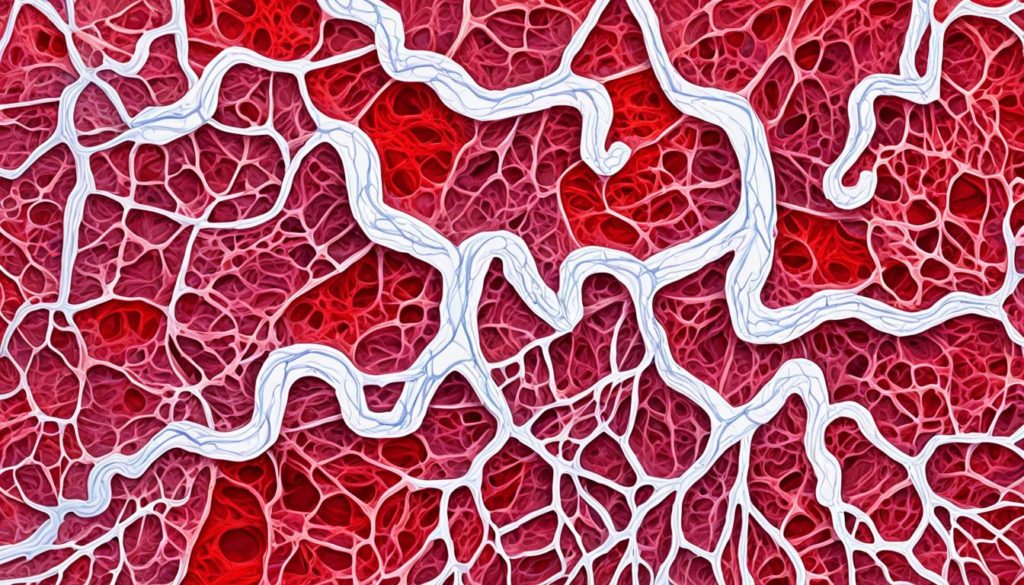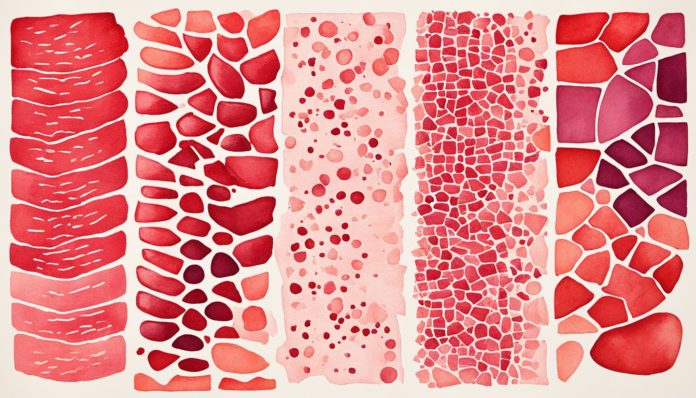About 10% of newborns in the U.S. show up with a red birthmark. It’s a common skin issue affecting many families yearly. Knowing the different types of red birthmarks, why they happen, and how to treat them is key. This overview will help you understand and find ways to deal with these skin conditions.
Key Takeaways
- Red birthmarks affect approximately 10% of newborns in the U.S.
- Understanding the nature of red birthmarks is crucial for accurate diagnosis and effective management.
- Common types include infantile hemangiomas, port wine stains, and stork bites.
- Treatment options range from laser treatments to surgical interventions.
- Early diagnosis and appropriate treatment can significantly improve outcomes for patients.
Understanding Red Birthmarks
Red birthmarks are a type of vascular birthmark found on the skin. They include a wide range of skin issues and vary in how they look, size, and where they are located. Knowing how to spot these marks is key. It helps tell them apart from other skin problems. Getting to know red birthmarks well is vital for the right identification and care.

Definition of Red Birthmarks
Known as vascular birthmarks, red birthmarks happen because of unusual blood vessels. These marks might be there when a baby is born or show up in the first months of life. What makes red birthmarks stand out is their red or pink color.
Common Characteristics
Red birthmarks have several typical features that help in spotting them:
- Color: Usually red, pink, or purple.
- Location: They can show up anywhere but often on the face, neck, and limbs.
- Prevalence: They are common in newborns and kids.
- Texture: The feel can be smooth, raised, or bumpy.
Knowing these details helps parents and doctors identify vascular birthmarks early on. This way, they can get help quickly if needed.
Types of Red Birthmarks
Red birthmarks come in different types. It’s key to recognize each type. We have infantile hemangiomas, port wine stains, and stork bites. Each has its own look, place on the body, and health effects. Knowing them is crucial for the right care.
Infantile Hemangiomas
Infantile hemangiomas are common. They start as raised, red spots soon after birth. They grow fast in the first year, then might shrink.
Most are not serious. But, some need treatment. This is if they affect functions or leave big skin changes.

Port Wine Stains
Port wine stains are pink, red or purple from birth. They can be anywhere but usually on the face and neck.
They don’t go away like hemangiomas. They might get darker and thicker with age. Laser treatments can make them lighter.
Stork Bites
Stork bites look like light pink or red patches. They’re often on the neck, forehead, or eyelids of newborns.
They’re not harmful. Most fade or disappear by age two. Understanding these marks helps in care and managing expectations.
| Type of Birthmark | Appearance | Common Locations | Potential Implications |
|---|---|---|---|
| Infantile Hemangiomas | Raised, red lesions | Face, scalp, chest, back | Possible complications if large or near vital structures |
| Port Wine Stains | Flat, pink to purple marks | Face, neck, limbs | Permanent, may require laser treatment |
| Stork Bites | Flat, light pink patches | Neck, forehead, eyelids | Usually fade on their own |
Causes of Red Birthmarks
The reasons behind red birthmarks are being uncovered through research. Scientists are looking into genetics and vascular differences. Even though we don’t fully understand them yet, we’re making progress.
Genetics might play a big role in some birthmarks, like infantile hemangiomas. Studies show they could be passed down in families. But not every case is the same, and we’re still figuring out how.
Vascular anomalies are also key in red birthmark formation. These involve unusual blood vessel growths in the skin. For example, port wine stains happen when these vessels grow too much in one spot.
Changes in hormones during pregnancy might lead to red birthmarks too. These changes can mess with how blood vessels grow in unborn babies. This can cause different vascular anomalies to show up.
Dermatology experts, like those from the American Academy of Dermatology, highlight the need for more research. As science gets better, especially with genetic studies and imaging, we’ll learn more about birthmarks.
| Contributing Factors | Description |
|---|---|
| Genetic Factors | Certain gene mutations can lead to a predisposition for birthmark formation. |
| Vascular Anomalies | Irregularities and malformations in blood vessels contribute to red birthmarks. |
| Hormonal Influences | Hormone level changes during pregnancy can impact fetal vascular development. |
In summary, red birthmarks come from genetics, vessel issues, or hormone changes. Research continues to shed light on these areas. This helps us understand and treat these marks better.
Infantile Hemangiomas
Infantile hemangiomas are very common birthmarks found in kids. They grow quickly, often surprising parents by how much they change. Knowing how they look, grow, and are diagnosed helps deal with them well.
Appearance and Growth
These birthmarks start as small, red spots or patches. They soon enter a fast growth phase. In this time, a hemangioma gets bigger and more noticeable.
The key stages of hemangioma growth are:
- Proliferative Phase: This stage is marked by fast growth, starting early in life.
- Plateau Phase: Here, the birthmark stops growing.
- Involution Phase: The hemangioma slowly shrinks and fades over years.
Knowing these growth stages helps doctors and parents manage the care needed.
Diagnosis
To diagnose infantile hemangiomas, doctors usually review medical history and check the child. Sometimes, more tests are needed for unclear cases or when there are complications. Such tests can include:
- Ultrasound: Checks the depth and size of the hemangioma.
- Magnetic Resonance Imaging (MRI): Used for more complicated cases.
- Biopsy: Done only when needed, to confirm diagnosis.
Getting an early, accurate diagnosis is key. It helps doctors watch how the hemangioma grows and start treatment early if needed.
Port Wine Stains
Port wine stains, also called nevus flammeus, are vascular birthmarks that look red or purple on the skin. They’re visible at birth and resemble spilled wine in color and texture.
Characteristics and Identification
These stains can grow and get darker over time. They often appear on the face, neck, arms, or legs and don’t disappear by themselves. Identifying them is easy because of their distinct color and surface. Dermatologists look at them closely, sometimes using special tools, to understand them better.
Implications and Concerns
While they’re mainly a beauty issue, port wine stains can affect how people feel, especially on the face. This can make someone feel very self-conscious and anxious about their looks. If not treated, the birthmarks can get bumpier and cause other skin problems.
Laser treatment is the best way to deal with port wine stains. It uses special lasers to attack the birthmark without hurting the nearby skin. Starting this treatment early can make the stain less noticeable and the skin smoother.
In summary, knowing about port wine stains, how to identify and treat them is important. Quick and right care can lessen their impact on someone’s life, helping them feel better about their appearance.
Stork Bites
Stork bites, also known as stork bites, are common nevi seen in newborns. They are also called salmon patches. These marks usually show up on the back of a newborn’s neck. They can also appear on the forehead or eyelids.
These birthmarks happen because blood vessels expand during fetal development. They have a pink or reddish color and are flat. Usually, they fade away by the time a child turns one or two years old.
Though stork bites are harmless and don’t need treatment, some parents think about cosmetic options if they don’t fade. But, most salmon patches naturally become lighter without needing to do anything. The medical world is studying if stork bites are related to other conditions. But, we need more research to be sure.
Knowing about stork bites can make parents less worried. It’s comforting to know that these marks are normal. Plus, they usually disappear as the baby grows.
Strawberry Hemangiomas
Strawberry hemangiomas are common in kids, showing up as a kind of vascular growth. They often start soon after a baby is born. In the first few months, they can grow fast.
What Causes Strawberry Hemangiomas?
The cause of strawberry hemangiomas is not fully understood. They seem to stem from anomalies in how new blood vessels form. Genetic factors and issues during pregnancy may play a role. These growths are usually benign and don’t generally threaten a child’s health.
Detection and Monitoring
Finding strawberry hemangiomas early is key. They’re recognizable by their unique look—a red, raised spot on the skin. It’s vital for parents and doctors to watch how these hemangiomas change over time, noting any big shifts in shape or color.
Seeing a skin specialist regularly helps track the hemangioma’s impact. Sometimes, an ultrasound or MRI is necessary to look more closely at it. Acting early helps avoid problems that could affect the child’s health or development.
Vascular Birthmarks
Vascular birthmarks are important in skin health. They include different types with unique features. They are key in dermatology because they vary a lot and can lead to complications.
Dermatology experts group vascular birthmarks by how they look and their blood vessels. Hemangiomas and port wine stains stand out. Each has its own clinical features and care needs.
Here’s a quick look at the key differences and similarities between common birthmark types:
| Subtype | Characteristics | Common Location | Implications |
|---|---|---|---|
| Infantile Hemangiomas | Raised, red skin growths | Head, neck, trunk | Typically resolve with age |
| Port Wine Stains | Flat, pink to dark red patches | Face, limbs | May thicken and darken over time |
| Stork Bites | Pale pink to red patches | Back of neck, forehead | Often fade by age 2 |
Knowing these skin anomalies is crucial in dermatology. It guides the care and follow-up plan. Spotting them early and diagnosing correctly means better management of birthmark types.
Treatment Options for Red Birthmarks
Understanding the right treatment for red birthmarks is key. Today, there are many methods including laser treatments, medications, and surgeries. Each method is tailored to fit individual needs.
Laser Treatments
The pulsed dye laser is a top choice for managing red birthmarks. It targets the birthmark’s blood vessels, making it less visible over time. This option works great for vascular birthmarks like port wine stains. Its benefits are little downtime and a high chance of success.
Medications
Medications are crucial for managing certain birthmarks, particularly hemangiomas. The beta-blocker Propranolol for hemangiomas is a standout treatment. It reduces the birthmark by shrinking its blood vessels. However, talking to a doctor is vital to understand its side effects and proper use.
Surgical Options
Surgery may be the best choice for some people. It’s considered when other treatments don’t work or if the birthmark is a health risk. Although it’s more invasive, surgery can completely remove unwanted birthmarks.
| Treatment Option | Benefits | Risks | Success Rate |
|---|---|---|---|
| Pulsed Dye Laser | Minimally invasive, high success for vascular birthmarks | Possible skin irritation, multiple sessions needed | High |
| Propranolol for Hemangiomas | Effective for shrinking hemangiomas, oral administration | Potential side effects, requires medical supervision | High |
| Surgical Options | Permanent removal, comprehensive solution | Invasive, longer recovery time | Varies |
Importance of Early Diagnosis
Spotting red birthmarks early is key for good care and stopping possible problems. Through detailed pediatric screening, doctors can figure out the birthmark’s type and how to treat it effectively.
Preventing birthmark complications is a big part of this. Some red birthmarks could lead to bigger health issues if not treated. For example, vascular birthmarks like port wine stains might need quick action to stop worse problems.
Starting care early is essential for watching and treating these birthmarks as children grow. Regular check-ups and treatment right away can make life much better for kids with these conditions.
This kind of care includes teaching and treatments that fit each child. Informing parents and caregivers helps them stay on top of treatments and check-ups. This keeps everyone ready and responsive.
A strong plan of regular doctor visits and early care helps avoid big problems from birthmarks. This way, every child can get the best care possible.
Conclusion
Understanding red birthmarks is key to managing them well. Knowing about conditions like Infantile Hemangiomas and Port Wine Stains early on helps a lot. Spotting changes early means a better choice in treatments, like laser or surgery.
Supporting patients is also very important. Offering help and understanding to those affected and their families matters. Whether it’s professional advice or a community’s support, it all helps improve life for people with red birthmarks.
It’s crucial to balance medical and cosmetic needs for red birthmarks. Being informed helps patients and families decide what’s best for them. In the end, knowing more and getting good support leads to better health and happiness for those dealing with red birthmarks.
FAQ
What are red birthmarks?
Red birthmarks look like red marks on the skin. They happen because of abnormal blood vessel clusters. These marks can vary in size, shape, and how deep their color is.
How are red birthmarks identified?
Doctors look at their color, shape, and where they’re located to identify red birthmarks. Names for some types are infantile hemangiomas, port wine stains, and stork bites. Pediatricians and dermatologists usually spot them by looking.
What causes red birthmarks?
The cause of red birthmarks isn’t completely known. But, they’re thought to come from genetics and issues with how blood vessels form. These result in abnormal spots on the skin.
What are infantile hemangiomas and how do they grow?
Infantile hemangiomas show up soon after a baby is born. They grow fast at first, then slowly start to shrink and fade.
How are port wine stains identified and what implications do they have?
Port wine stains are flat and can range from red to purple. You can tell them apart by their color and smooth feel. These marks might hint at other health problems and affect how people feel about their looks.
What treatments are available for red birthmarks?
There are many treatments, like laser therapy and medicines, for red birthmarks. Surgery might also be an option. The treatment chosen depends on how severe the birthmark is.
Can red birthmarks be removed?
Yes, many red birthmarks can be treated well. This often leads to them fading a lot or going away completely. Advances in treatments have made removing these marks more successful.
What are stork bites and do they fade over time?
Stork bites are flat, red spots that are often on a newborn’s neck. They usually go away over time without treatment.
Why is early diagnosis of red birthmarks important?
Finding these marks early helps doctors treat them better. This can stop more serious problems and make treatments work better. That’s why checking babies early is key.
Are there any risks associated with birthmark treatments?
Treatments like lasers and drugs are safe but can have side effects. These include skin problems or the mark not going away fully. Talking to a skin doctor can help weigh the pros and cons.


